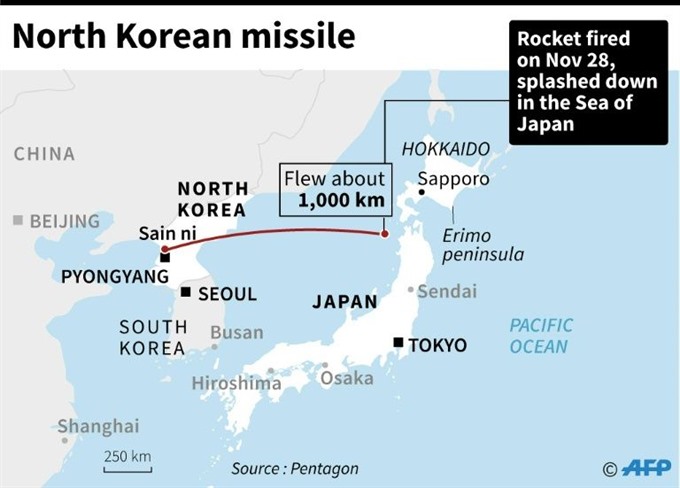 World
World

North Korea test fired an intercontinental ballistic missile on Wednesday, in a major challenge to US President Donald Trump after he slapped fresh sanctions on Pyongyang and declared it a state sponsor of terrorism.
 |
| Map showing the approximate path of a missile launched by North Korea on November 28. — AFP Photo |
SEOUL — North Korea test fired an intercontinental ballistic missile on Wednesday, in a major challenge to US President Donald Trump after he slapped fresh sanctions on Pyongyang and declared it a state sponsor of terrorism.
It was the nuclear-armed North’s first ballistic test in more than two months and an initial Pentagon assessment said the ICBM flew about 1,000 kilometers before splashing down within Japan’s maritime Economic Exclusion Zone.
At least one expert said its lofted trajectory suggested an actual range of 13,000 kilometres that would bring every city in the continental United States within range.
Trump, who has previously threatened North Korea with "fire and fury," was guarded in his immediate response, as the UN Security Council agreed to convene an emergency session to discuss the latest provocation.
"I will only tell you that we will take care of it," Trump said at the White House. "It is a situation that we will handle," he added, without elaborating.
North Korea’s immediate neighbours were less restrained, with Japanese Prime Minister Shinzo Abe calling the test an intolerable, "violent" act and South Korean President Moon Jae-In condemning Pyongyang’s "reckless" behaviour.
The South Korean military responded by staging a precision-strike missile exercise as it has done following previous North Korean tests.
Prior to Wednesday’s launch, the North’s last missile test was on September 15 and the subsequent pause had prompted some to speculate whether the North might be willing to embrace a negotiated solution to the nuclear standoff.
Diplomatic options
Trump insisted there would be no change to his administration’s "maximum pressure campaign" which has sought to curb Pyongyang’s nuclear weapons programme with tightened sanctions backed by dire warnings of massive retaliation in the event of any attack.
But his secretary of state, Rex Tillerson, also stressed that diplomatic options remained "viable and open."
It was the North’s third successful ICBM test and David Wright, a co-director at the Union of Concerned Scientists, said the flight parameters pointed to a "significantly longer" range than previous launches.
"Such a missile would have more than enough range to reach Washington DC, and in fact any part of the continental United States," he said.
While Pyongyang has yet to prove its mastery of the re-entry technology required to bring a warhead back through the Earth’s atmosphere, experts say it is on the threshold of developing a working nuclear strike capability against US cities.
Tensions over the North’s weapons programme peaked after Pyongyang conducted its sixth and most powerful nuclear test in September and then fired an intermediate-range missile over Japan.
US Defense Secretary Jim Mattis said Wednesday’s test went higher than ever before and was a step toward North Korea building missiles that can "threaten everywhere in the world, basically."
There was no immediate reaction from China, the North’s sole ally and economic lifeline, which has come under repeated US pressure to do more to rein in Pyongyang’s nuclear ambitions.
China has pushed for a "dual track approach" to the crisis which would see the United States freeze its military drills in South Korea while North Korea would halt its weapons programmes.
Washington has rejected that approach, and last week unveiled new sanctions targeting North Korean shipping, as well a number of Chinese companies doing business with the pariah state. — AFP




